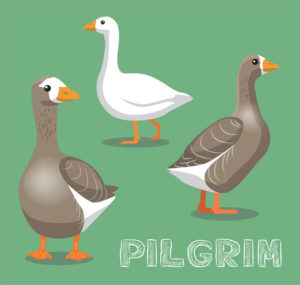Goose Breeds:
There are about 15 breeds of domesticated geese. Basically, the goose is raised for meat. Personally, I like goose meat much better than turkey. Whatever breed of goose you prefer, you’ll probably want to separate breeds or choose only one, because purebred geese are more marketable than those that are crossbred. An exception is the cross between the White Chinese gander and an Embden goose, a match that produces a goose that matures quickly to market weight.
Chinese. The closest thing to an eggs-and-meat goose breed is the White Chinese, which is almost as lovely on the water as a swan, gives noisy warning like a watchdog, and is a good forager and weeder. But they are less hardy than some geese in winter. The Chinese need shelter at below-freezing temperatures and heat at 20 ̊F or lower. You’ll at least need to provide them a south-facing lean-to with a straw-covered floor. They are about half the size of the larger breeds—10–12 lb.—but still big enough for a Thanksgiving dinner, though connoisseurs complain that the Chinese’s carcass configuration is not as good as that of the larger breeds. But, the Chinese has a naturally leaner meat. The Chinese is the smallest bird and the best egg-layer among the goose breeds with quite good fertility. They produce from 40 to 65 eggs per year. Their eggs are large, white, and—like any other bird egg—just fine for cooking and baking. Some strains of Chinese have lost much of their broody urge; others still have it.
Pilgrim. This is an interesting, more recently developed breed (developed before the Second World War). The adult male is white with blue eyes. The adult female is gray and white with hazel eyes, which makes it easy to distinguish it from the male. Even day-old goslings are sex-linked to white and gray. The Pilgrim ganders are said to be friendly to humans and diligent in helping rear their goslings. Pilgrims are cold-weather hardy, being able to do without shelter even in sub-zero weather. Pilgrims are smaller than Embdens, rating as a medium-sized goose, and weighing 14 lb. (goose) to 16 lb. (gander).

Toulouse. These geese have broad bodies of dark gray with white abdomens. They have reddish-orange legs and toes and orange bills. They are hardy in winter and are basically meat birds that grow fast—a pound or more a week for the first 12–14 weeks—and end up quite large. Toulouse are meat specialists. A Toulouse will have fall weights from 20 to 25 lb. Some Toulouse males grow quite large, up to 26 lb., if allowed to grow to maturity—which requires a full year. Toulouse geese have another advantage: they are the best goose for reproducing themselves, though the White Chinese and Embden geese also go broody very well. Although the female will lay about 25 eggs over a month, let her set on only 15. Giant Toulouse geese are an extra-heavy variant of the Toulouse that has the reputation of being a quiet breed, which may be kept unfenced because they won’t wander far. Giant Toulouse geese will lay about 60 eggs per season, but hatchability runs only a little over 50 percent. The Giant Toulouse is said to be a relatively poor brooder and mother.
Embden. These geese are pure white, have very nice feathers, and are also hardy in winter. Like the Toulouse, they grow fast, although they are slightly smaller. The White Embden is the commercial grower’s favorite. A gosling can go from 4 oz. at hatching to 11 lb. in 10 weeks. At the end of 12–14 weeks you can put 10–12-lb. birds in your freezer. Or let them grow longer. An Embden will have fall weights of 18–20 lb. Embden geese go broody very well and will lay between 35 and 40 eggs a year.
African. The African goose is not as heavy as the Toulouse or White Embden, but it matures earlier. It is light brown with dark brown accents and a black knob on its head. The dressed carcass is on the lean side, with an abundance of pin feathers. The African goose is a heavier relative of the Chinese, weighing 14 lb. (goose) to 16 lb. (gander) at butchering stage, a couple pounds heavier as a breeder. It also is a relatively good layer. African geese are significantly noisier than other breeds.

Royal Chinese. This rare breed is the largest goose in captivity. They can exceed the adult weight of most other breeds when they are only 10 weeks old.
Buff and Sebastopol Geese. Both are unsuitable for meat and egg production. The Sabastopol does have beautiful curly feathers, making it fine for showing or to keep for a pet.
Canada or Wild Geese. These are best left wild. Although you can keep one from flying off by penning it or clipping its wings, they give you neither plentiful eggs nor good meat and you need a permit to keep one.

More from The Encyclopedia of Country Living:
(c)2012 by Carla Emery. All rights reserved. Excerpted from The Encyclopedia of Country Living by permission of Sasquatch Books.













1 Comment
Where can a buy geese, please give me the address and the phone number, to be ship to Guam ..